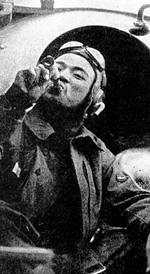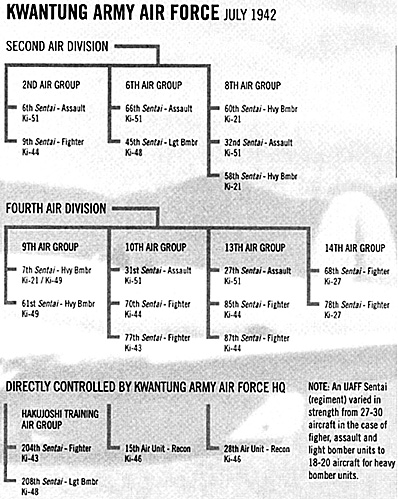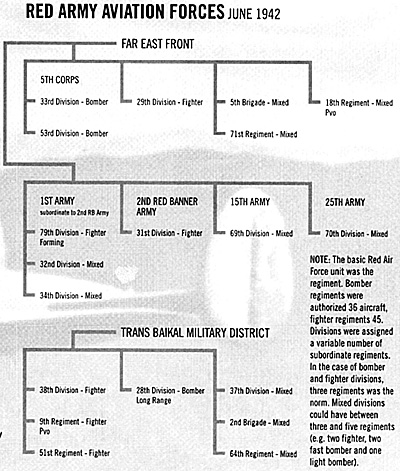 THE IMPERIAL JAPANESE ARMY AIR FORCE (IJAAF)
THE IMPERIAL JAPANESE ARMY AIR FORCE (IJAAF)
Just as the Kwantung Army was the cream of the IJAs ground forces, the Kwantung Army Air Force was the most important of the IJAAF's formations. In 1941, the IJA Air Force had been consolidated in the home islands and in Manchuria. Of the some operational 128 squadrons in the air force, approximately 100 were stationed in Manchuria and Korea in preparation for war against the Soviet Union.
During this period, the Kwantung Army's air fleet was built around the 2nd and 5th Joint Air Groups with seven subordinate air brigades. At the conclusion of the Kwantung Army's buildup in August 1941, 600 combat aircraft were available. Late in 1941, the IJAAF began to transfer units to the south in preparation for action against the Allies. This eventually entailed the loss of the 5th Air Group and the 10th and 12th Air Brigades. The figure below details the Kwantung Army Air Force's order of battle in late 1941.
The overall quality of the IJAAF's aircraft was mediocre in 1941 but compared favorably to the older generation Soviet aircraft still in service in the Far East. In 1941, the standard Japanese Army Air Force fighter was the obsolescent Nakajima Ki-27 (Allied codename NATE), which entered service in 1938. It was a supremely maneuverable aircraft with a fixed undercarriage and the IJAAF's first enclosed cockpit. Its armament was limited to two machine guns. During the Nomonhan clash, the Ki-27, with its superb pilots, was good enough to establish ascendancy over the primary Soviet fighter, the Polikarpov I-16. However, this was not without heavy attrition to the four fighter regiments involved.
 While the Ki-27's agility made it a formidable opponent to the Soviet pilots who attempted to dogfight with it, its short range restricted its operational use. The Ki-27 remained in service in Manchuria until the end of the war. The primary replacement for the Ki-27 was the Nakajima Ki-43 (OSCAR), which had just begun to enter service in October 1941. Like the Ki-27, the Ki-43 was very maneuverable and remained lightly armed. Nevertheless, the Ki-43 remained in front-line service throughout the war and would have been a mainstay fighter for any 1942 attack against the Soviet Union.
While the Ki-27's agility made it a formidable opponent to the Soviet pilots who attempted to dogfight with it, its short range restricted its operational use. The Ki-27 remained in service in Manchuria until the end of the war. The primary replacement for the Ki-27 was the Nakajima Ki-43 (OSCAR), which had just begun to enter service in October 1941. Like the Ki-27, the Ki-43 was very maneuverable and remained lightly armed. Nevertheless, the Ki-43 remained in front-line service throughout the war and would have been a mainstay fighter for any 1942 attack against the Soviet Union.
The IJAAF bomber force was equipped with a number of aircraft that were showing signs of obsolescence in 1941. These designs had proved successful in China, but against the Allies they would prove to be vulnerable to interception. Against the outdated Soviet fighters of the time, they would have performed better, but still would have required fighter escort to remain effective. Three types of light bombers were in service. The single engine Mitsubishi Ki-30 (ANN) and Kawasaki Ki-32 (MARY) were unspectacular, but reliable.
Their planned replacement, the twin engine Kawasaki Ki-48 (LILY) had entered service in 1940 but offered an inadequate bombload, insufficient defensive armament, and did not possess adequate speed to avoid interception by even the dated Soviet fighters of the day.
The IJAAF's standard heavy bomber was the two engine Mitsubishi Ki-21 (SALLY), which was well liked by its crews but offered mediocre performance and bombload. By 1942, the Kwantung Army's bomber force was little changed except for the introduction of the Mitsubishi Ki-51 (SONIA) assault aircraft in some units replacing older Ki-30 and Ki-32 aircraft.
 THE RED AIR FORCE
THE RED AIR FORCE
The year 1941 caught the Red Air Force in the middle of a massive transformation. A series of new aircraft were coming into service and the force was in the throes of a massive expansion program to meet the German threat. The dramatic expansion and the introduction of new weapons, combined with the aftermath of the purge, translated into a temporary reduction in combat readiness.
The organization of the Red Air Force in the Far East in June 1941 is shown below. Soviet doctrine at the time called for air units to be controlled by one of the army headquarters in the Far East, reducing their operational flexibility. In the summer of 1942, Soviet air units were formed into Air Armies but the Red Air Force continued to struggle with the problem of operational flexibility. The Japanese estimated that the Soviets possessed 2,800 aircraft in the theater in 1941; by the end of the year transfers to the west had reduced their estimate to 1,000 aircraft.
The standard Soviet fighter in 1941 was the Polikarpov I-16. First flown in 1933, the I-16 was obsolete by 1941. It was much more heavily armed than its Japanese counterparts, but over time additional weight had impacted its performance. The I-16 had a higher speed than the Ki-27 and Soviet pilots eventually learned to use this advantage in diving attacks and not to attempt to dogfight the Japanese.
The replacement for the I-16 was the Lavochkin LaGG-3, which entered service in 1941. This was an unpopular aircraft with poor performance. Also present in small numbers, having entered service in April 1941, was the Mikoyan Gurevich MiG-3, which was designed for high altitude operations but which possessed unsatisfactory performance at medium and low altitudes.
The mainstay of the Soviet bomber force was the Tupolev SB-2 series bomber that was produced in great numbers during the late 1930's. When it originally entered service in 1936, this fast twin engine aircraft outclassed all other medium bombers of its era. In 1941, its speed no longer offered it immunity to interception and it was destroyed in droves by the Luftwaffe in the opening months of the war.
The SB-2 was augmented in the Far East by small numbers of four engine Tupolev TB-3 heavy bombers. This ungainly aircraft, whose design dated to 1926, had performed effectively during the Nomonhan Incident flying at night. The very capable Petlyakov Pe-2 dive-bomber and the Ilyushin IL-2 assault aircraft, both just coming into service, were not present in the Far East in 1941 in any significant numbers.
While the Red Air Force maintained a numerical advantage over the IJAAF, as proven over Mongolia during the Nomonhan Incident, Japanese aircrews were superior. The Japanese claim of losing 168 aircraft during the incident is approximately correct. Soviet losses are difficult to determine but were between 400-700. While Soviet fighter pilots received 50-90 hours of flight training with little attention given to combat maneuvering before being thrown into action, the experienced Japanese were receiving 200 flight hours per year. Additionally, large numbers of IJAAF aircrew had gained considerable combat experience in China since 1937. Red Air Force personnel would have found themselves having to learn quickly against the Japanese.
North Wind Rain Japanese Invasion of Manchuria
- Introduction and Background
The Nomohan Incident
Preparations for the Next Round
Japanese 1941 Campaign Plan
Into 1942 and Beyond
Kwantung Army Close Up
The Soviets Prepare
The Red Army and the Far East
The Red Army in 1942
Opposing Air Forces
Red Army Rifle Division April 1941 TO&E
Red Army Rifle Division July 1942 TO&E
Red Army Rifle Brigade July 1942 TO&E
Red Army Tank Brigade July 1942 TO&E
Red Army Far Eastern Front June 1941
Red Army Trans-Baikal Military District June 1941
Large Map: Kwangtung Army Deployment August 1941 (slow: 116K)
Jumbo Map: Kwangtung Army Deployment August 1941 (very slow: 397K)
Alternative History: 2nd Russo-Japanese War
Back to Table of Contents -- Against the Odds vol. 2 no. 1
Back to Against the Odds List of Issues
Back to MagWeb Magazine List
© Copyright 2003 by LPS.
This article appears in MagWeb.com (Magazine Web) on the Internet World Wide Web.
Other articles from military history and related magazines are available at http://www.magweb.com
* Buy this back issue or subscribe to Against the Odds direct from LPS.
